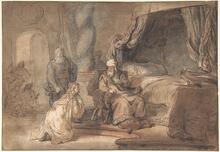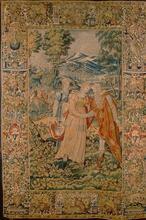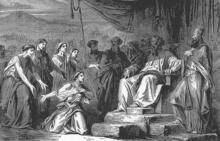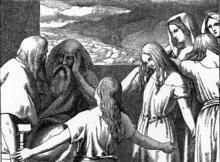Gomer: Bible
Gomer was the wife of the prophet Hosea. In some translations she is labeled a prostitute, but the more accurate description is that she was simply promiscuous and had extramarital relations. Gomer and Hosea’s relationship, and ancient Israelite marriage, shows how women were ostracized for extramarital sex while such behavior was tolerated if not encouraged in men, paralleling the relationship between Israel and God. Gomer is also never given the ability to speak for herself but is rather shown as the victim of abuse from both Hosea and God as punishment for her promiscuity. However, conventional analyses of Gomer are based on the traditional modern gender dichotomy, and interpreting Gomer’s narrative with a familial lens can also be elucidating.
The eighth century B.C.E. prophet Hosea’s famous metaphor of God as faithful husband to Israel as his adulterous wife (Hosea 2) is juxtaposed with the story of Hosea’s own disastrous marriage to Gomer, Diblaim’s daughter (Hosea 1; 3). It is difficult, however, to separate historical facts about the couple’s domestic problems from the theological message expressed through them.
Gomer and Hosea’s Marriage
Scholars have advanced a number of theories to reckon with historical questions about the portrayal of Gomer in Hosea 1-3. Some commentators regard Hosea and Gomer’s marriage as an allegory, not meant to be taken literally. Such an interpretation would perhaps preserve Gomer’s moral goodness by erasing her existence as a real woman and having her serve God’s purposes. Others think that Gomer actually was a licentious woman, maybe even a prostitute, whom Hosea felt obliged to marry and whose illegitimate children Hosea adopted. A mediating position interprets the command to marry the immoral Gomer proleptically (after the fact): Gomer was chaste at the time of marriage, but subsequently became unfaithful to Hosea as an adulteress, a common harlot, or a temple prostitute.
Some try to vindicate Gomer's reputation by insisting that she should not be equated with the woman in Hosea 3, another wife, whom Hosea was commanded to marry and whose promiscuity is unfairly laid upon Gomer. A variant of this position regards the blameless Gomer of Hosea 1 becoming wrongly identified with the prostitute whom Hosea hires (rather than marries) in Hosea 3. In order to preserve the sanctity of marriage, still other interpreters argue that Hosea did not actually marry Gomer. The verb take in 1:2 could mean “marry a wife” or “take a woman sexually.” Following the latter sense, Hosea was commanded to have sex with two unchaste women: Gomer and the unnamed woman of Hosea 3. His symbolic actions are not meant to parallel the marriage between God and Israel (Hosea 2).
Most commentators today understand the unnamed woman in Hosea 3 to be Gomer of Hosea 1. The standard opinion that Gomer was a prostitute is based on misleading translations of eshet zenunim in 1:2, which have Hosea marrying “a wife of whoredom” (NRSV, JPS), “a wife of harlotry” (RSV), “a harlot wife” (NAB), or simply “a whore” (NJB). However, Gomer is never labeled as a zonah, the technical term for a prostitute. Nor is Gomer called a kedesha (literally, “holy one”), wrongly translated as “temple prostitute” or “cult prostitute” to describe the daughters of Israel in 4:14. Kedesha refers to a woman serving in the cult. The nature of her activity (whether sexual or not) is, however, difficult to reconstruct from the extant evidence. In the prophet’s mind, her rituals involved sexuality, but it would be a mistake to accept his polemical condemnations at face value.
For Hosea, Gomer is a “wife of whoredom,” not because she is a prostitute, but because, according to the mores of Israel, she is blatantly licentious and wanton. In her sexual activity, Gomer is condemned as being “like a whore,” although she is not a prostitute by profession. As a promiscuous wife, Gomer is much more threatening to the social order than a prostitute—a woman marginalized but still tolerated in Israel. An adulterous woman could never be permitted in a patrilineal society based on the principle of male descent and inheritance through legitimate sons. Through prostitution, men were allowed socially condoned sexual access to “other” women who were not their wives. Women, on the contrary, were permitted no other men besides their husbands. Because of this unequal sexual access to other partners, which itself is based on other gendered asymmetries, ancient Israelite marriage becomes a powerful metaphor, delineating the exclusive boundaries of God’s covenant with Israel and Israel’s infidelity to that covenant by worshipping other gods.
During the course of their marriage, Gomer bears Hosea three children with symbolic names: a son, Jezreel, meaning, “God sows” (1:4–5); a daughter, Lo-ruhamah, meaning “not pitied” (1:6–7); and another son, Lo-ammi, meaning “not my people” (1:8–9). Each child symbolically represents the deteriorating state of the nation.
God’s Actions Against Gomer
The story of God’s marriage to Israel interrupts that of Hosea’s marriage to Gomer and becomes a paradigm for Hosea’s treatment of Gomer in Hosea 3. Highlighted in Hosea 2 is the forgiving love of God, who renews covenantal vows with his wayward but repentant Israel. However, the metaphorical vehicles, describing God’s punishment of “his wife” to make her repent, become dangerously similar to acts of domestic violence. God the husband will “strip her naked,” “make her like a wilderness,” “kill her with thirst” (2:3), isolate her (2:6), refuse to provide for her well-being (2:9), humiliate her before her lovers (2:10), and so forth.
Like God the husband, Hosea is commanded to “love” the adulterous wife (Hos 3:1), whom he was bidden to marry (Hos 1:2–3). As God does for Israel, Hosea restores provisions for Gomer’s livelihood that he had withdrawn silver for clothes, barley for food, and wine for drink (3:2; compare 2:14). Just as God isolates Israel from her lovers (2:6–7), so does Hosea segregate Gomer from her paramours and even refrains from sexual intercourse with her himself.
Whereas Hosea 2 clearly describes the physical and emotional violence God inflicts upon his wife to punish her, Hosea 3 is selective in portraying the prophet’s chastisement of Gomer: no descriptions of Hosea stripping and humiliating her, no reports of his withholding her food and clothing, and no accounts of his physical mistreatment of her. Yet if Hosea models God to the fullest extent, these acts of “love” are certainly implied in Hosea 3. But what a man views as love, a woman experiences as abuse. The text’s silence about these acts of “love” coincides with the reality that most cases of wife battering are private, not public, matters.
Significance of Gomer’s Portrayal
It is tragic that Gomer is silent in Hosea 1 and 3. She is basically remembered as Hosea’s unfaithful wife. Yet one wonders about her account of domestic life with her famous prophetic spouse, who had immortalized their marriage as a significant, but problematic, metaphor of covenantal love. Gomer’s muteness only emphasizes the extent to which women have been left out of discussions that visualize the deity as male and the sinful as female.
These discussions, by both feminists and traditional interpreters, are rooted in paradigmatic Western dichotomies that link God with the male, and matter and nature with the female and with sexuality. Because the prophet Hosea’s life precedes the development of this dualistic structure, it is also possible to read his metaphor as a commentary on eighth century BCE sociopolitical conflicts. His true metaphor may be a family metaphor rather than a marriage one. He may be using the centrality of family life to critique the larger social body. Like the family, the community of Israel is disintegrating. This reading calls into question the authority of traditional interpretations, which are embedded in the sexism and misogyny of Western culture and calls for new ways of thinking about the body, woman, and the sacred.
Bird, Phyllis. “‘To Play the Harlot’: An Inquiry into an Old Testament Metaphor.” In Gender and Difference in Ancient Israel, edited by Peggy L. Day, 75–94. Minneapolis: 1989.
Keefe, Alice. “The Female Body, the Body Politic, and the Land: A Sociopolitical Reading of Hosea.” In A Feminist Companion to the Later Prophets, edited by Athalya Brenner, 70–100. Sheffield, England: 1995.
Meyers, Carol, General Editor. Women in Scripture. New York: 2000.
Sherwood, Yvonne. “The Prostitute and the Prophet: Hosea's Marriage.” Literary and Theoretical Perspectives. Sheffield Academic Press, 1996.
Weems, Renita J. Battered Love: Marriage, Sex, and Violence in the Hebrew Prophets. Minneapolis: 1995.
Yee, Gale A. “Hosea.” Women’s Bible Commentary, edited by Carol A. Newsom and Sharon H. Ringe, 195–202. Kentucky: 1992; expanded edition, 1998.









